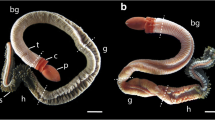Summary
The sexual development of Ephydatia fluviatilis involves a ciliated parenchymula-larva. The mature larva leaves the body of the “mother” sponge through the excurrent canal system and arrives eventually in the outside world by way of the osculum. At this stage the types of cells found in the adult sponge are already present in the larva. The released larva swims around for a while and then, after a period of between 3 and 48 hours, it attaches, usually with the anterior, larval cavity-bearing pole, onto the substratum. While it is attaching and spreading itself out, the larva undergoes a metamorphosis. The most notable stages of this metamorphosis are as follows: (a) disintegration of the ciliated epithelium from the anterior pole of the larva and its substitution by a pinacocyte epithelium, (b) splitting of the larval cavity and (c) integration of the remains into the developing canal system together with the creation and further development of the organic features of a functioning sponge.
Similar content being viewed by others
References
Bergquist PR, Green CR (1977) An ultrastructural study of settlement and metamorphosis in sponge larvae. Cah Biol Mar 18:289–302
Bergquist PR (1978) Sponges. Univ Calif Press, Los Angeles: 99–127
Bergquist PR, Glasgow K (1986) Developmental potential of ciliated cells of ceractinomorph sponge larvae. Exp Biol 45:111–122
Borojevic R, Lévi C (1965) Morphogénèse expérimentale d'une éponge apartir de cellules de la larvae nageante dissociée. Z Zellforsch 68:57–69
Borojevic R (1966) Etude expérimentale de la différenciation des cellules de l'éponge au cours de son développment. Dev Biol 14:130–151
Brien P, Meewis H (1938) Contribution a l'étude de l'embryogénèse des spongillidae. Arch Biol 49:177–250
Brien P (1973) Les Démosponges. In: Grassé PP (d.) Traité de Zoologie, Vol III, Fasc 1 Mason Cie Paris: 133–461
Evans R (1899) The structure and metamorphosis of the larva of Spongilla lacustris. Q J Microsc Sci 43:362–477
Goette A (1886) Untersuchungen zur Entwicklungsgeschichte von Spongilla lacustris. In: Abhandl Entw Tiere 3:1–64
Hartman WD (1958) Natural history of the marine sponges of Southern New England. Bull Peabody Mus Natur Hist (Yale Univ) 12:1–55
Höhr D (1977) Differenzierungsvorgänge in der keimenden Gemmula von Ephydatia fluviatilis. W Roux's Archiv 182:329–346
Langenbruch PF (1981) Zur Entstehung der Gemmulae bei Ephydatia fluviatilis L. (Porifera). Zoomorphology 97:263–284
Langenbruch PF (1984) Vergleichende rasterelektronenmikroskopische Darstellung der Gemmulaschalen von Ephydatia fluviatilis, Ephydatia muelleri und Spongilla lacustris (Porifera). Zoomorphology 104:79–85
Lévi C (1956) Etude des Halisarca de Roscoff. Embryologie et systématique des démosponges. Arch Zool Exp Gén 93:1–181
Maas O (1893) Die Embryonalentwicklung und Metamorphose der Cornacuspongien. Zool Jahrb Abt Anat Ontog Bd VII:331–448
Meewis H (1939) Contribution a l'étude de l'embryogénèse des Chalinidae: Haliclona limbata (Mont.). Ann Soc R Zool Belg 70:201–243
Nöldeke B (1894) Die Metamorphose des Süßwasserschwammes. Zool Jahrb Abt Anat Ontog 8:153–189
Paulus W, Weissenfels N (1986) The spermatogenesis of Ephydatia fluviatilis (Porifera). Zoomorphology 106:155–162
Saller U, Weissenfels N (1985) The develepment of Spongilla lacustris from the oocyte to the free larva (Porifera, Spongillidae). Zoomorphology 105:367–374
Saller U (1988) Oogenesis and larval development of Ephydatia fluviatilis (Porifera, Spongillidae). Zoomorphology 108:23–28
Simpson TL (1984) The cell biology of sponges. Springer, New York
Weissenfels N (1982a) Rasterlektronenmikroskopische Histologie von spongiösem Material, Microsc Acta 85 (4):345–350
Weissenfels N (1982b) Bau und Funktion des Süßwasserschwammes Ephydatia fluviatilis L. (Porifera). IX. Rasterelektronenmikroskopische Histologie und Cytologie. Zoomorphology 100:75–87
Wilson HV (1935) Some critical points in the metamorphosis of the halichondrine sponge larvae. J Morphol 58:285–353
Author information
Authors and Affiliations
Rights and permissions
About this article
Cite this article
Wielspütz, C., Saller, U. The metamorphosis of the parenchymula-larva of Ephydatia fluviatilis (Porifera, Spongillidae). Zoomorphology 109, 173–177 (1990). https://doi.org/10.1007/BF00312468
Received:
Issue Date:
DOI: https://doi.org/10.1007/BF00312468




